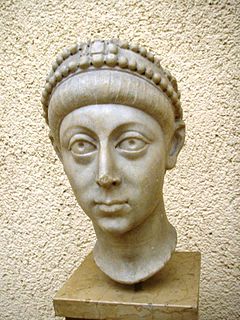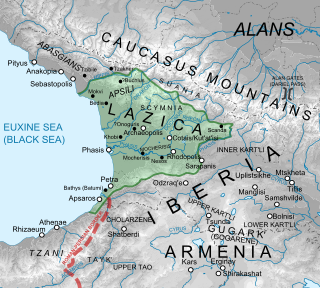Related Research Articles

Arcadius was Roman emperor from 383 to 408. He was the eldest son of the Augustus Theodosius I and his first wife Aelia Flaccilla, and the brother of Honorius. Arcadius ruled the eastern half of the empire from 395, when their father died, while Honorius ruled the west. A weak ruler, his reign was dominated by a series of powerful ministers and by his wife, Aelia Eudoxia.

Theodosius II was Roman emperor for most of his life, proclaimed augustus as an infant in 402 and ruling as the eastern Empire's sole emperor after the death of his father Arcadius in 408. His reign was marked by the promulgation of the Theodosian law code and the construction of the Theodosian Walls of Constantinople. He also presided over the outbreak of two great Christological controversies, Nestorianism and Eutychianism.

Leo I, also known as "the Thracian", was Eastern Roman emperor from 457 to 474. He was a native of Dacia Aureliana near historic Thrace. He is sometimes surnamed with the epithet "the Great", probably to distinguish him from his young grandson and co-augustus Leo II.

Constans II, nicknamed "the Bearded", was the Eastern Roman emperor from 641 to 668. Constans was the last attested emperor to serve as consul, in 642, although the office continued to exist until the reign of Leo VI the Wise.

John Bagnell Bury was an Anglo-Irish historian, classical scholar, Medieval Roman historian and philologist. He objected to the label "Byzantinist" explicitly in the preface to the 1889 edition of his Later Roman Empire. He was Erasmus Smith's Professor of Modern History at Trinity College Dublin (1893–1902), before being Regius Professor of Modern History at the University of Cambridge from 1902 until his death.

Eutropius was a fourth-century Eastern Roman official who rose to prominence during the reign of emperor Arcadius. He was the first eunuch to become a consul in the Roman empire.

The Battle of the Masts or Battle of Phoenix was a crucial naval battle fought in 654 between the Muslim Arabs led by Abu al-A'war and the Byzantine fleet under the personal command of Emperor Constans II. The battle was part of the earliest campaign by Muawiyah to reach Constantinople and is considered to be "the first decisive conflict of Islam on the deep".
Marcellus was an East Roman (Byzantine) judicial official, one of the closest aides of the Byzantine emperor Justinian I and commander of the imperial bodyguard of the excubitores in circa 541–552.
Flavius Celer was a Byzantine general and magister officiorum under Emperor Anastasius in the early 6th century.
Praejecta or Praiecta was a niece to Byzantine emperor Justinian I by blood and of his empress Theodora by marriage.
Domentzia was a name shared by the mother of the Byzantine emperor Phocas, and a daughter of the same emperor, likely named after her paternal grandmother.
Domentziolus or Domnitziolus (Δομνιτζίολος) was a brother of the Byzantine emperor Phocas.
Ardagast or Radogost was a 6th-century South Slavic chieftain under King Musokios of the Antes.
Alexander was a Byzantine military officer, active in the reign of Maurice. He is styled a taxiarch in the accounts of Theophylact Simocatta. He is known for his part in campaigns against the South Slavs.
Anatolius was a Byzantine official, active in the reign of Justinian I. He held the titles of curator domus divinae and honorary consul. He was killed in the Constantinople earthquake of 557.

The siege of Phasis took place in 555–556 during the Lazic War between the Byzantine and Sasanian Empires. Expecting an easy victory, the Persians besieged the town of Phasis in Lazica, held by the Byzantines, but were defeated in the ensuing irregular battle. The main source for the siege is the 6th-century historian Agathias.

The Battles of Viminacium were a series of three battles fought against the Avars by the Eastern Roman Empire. They were decisive Roman successes, which were followed by an invasion of Pannonia.
The siege of Onoguris occurred in 554 or 555 AD during the Lazic War between the Byzantine Empire and the Sasanian Empire.
Tarrach was a Hun military officer for the East Roman Empire. He was the assassin of the officer Cyril. Tarrach was credited as the "fiercest of the Huns".
References
- ↑ Bury, John Bagnell (1889). A History of the Later Roman Empire from Arcadius to Irene, Vol. I. MacMillan & Co. pp. 458–462. ISBN 978-1-4021-8369-0.
- ↑ Maenchen-Helfen, Otto J. "The World of the Huns. Chapter IX. Language". www.kroraina.com. Retrieved 28 October 2022.
- ↑ Bury, John Bagnell (1966). History of the Later Roman Empire, from Arcadius to Irene (395 A.D. to 800 A.D.). Hakkert. p. 458. Retrieved 28 October 2022.